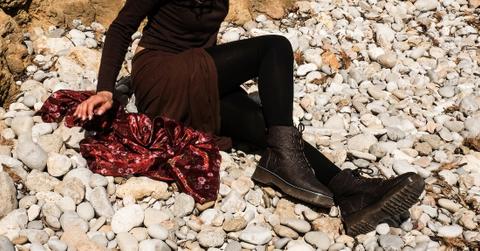This Company Is Making Shoes Out Of Used Airbags and Tires
Portugal-based fashion company NAE Vegan is adding a boot made from upcycled airbags and old car tires to their collection of stylish, ethically made shoes.
Updated Nov. 19 2020, 9:39 p.m. ET
Where vegan leather was once a poor substitute for the real thing, innovators around the world are reinventing the material in ways that not only save animal's lives but offer creative ways to avoid waste, too. The latest to join the trend is Portugal-based shoe brand NAE.
NAE is built on the premise of creating stylish, comfortable shoes without harming animals, filling a void the founders Alex and Paula Pérez saw in the market. And while all their shoes are made with vegan leather, the latest debut for the winter collection is a boot made from recycled nylon sourced from airbags with soles made from old tires.
“We think that is very important to show to the people that today we can work with animal-friendly materials and have stronger shoes at the same time,” Alex told VegNews. “All the products we manufacture are ethical and designed for the consumer and their daily comfort.”
The boots are also hand-stitched and use animal-free glue. According to Alex, they are also "more durable and comfortable than boots made with animal-based materials," and, of course, they're more sustainable.
Using vegan leather is sustainable for several reasons. For one, farming cattle is detrimental to the environment. The entire agriculture sector is responsible for 18 percent of the total release of greenhouse gases world-wide, and cows and other similar animals raised for milk, meat and fiber contribute around two billion metric tons of CO2-equivalents per year. Plus, cattle farming often requires clearing tropical and rain forests to create grazing land. Livestock now use 30 percent of the earth's entire land surface, and it's growing significantly.
That said, not all faux leather is good for the environment. Though some natural materials are sometimes used (like cork), the majority of it is plastic-based, hence the classic term "pleather," i.e. leather and plastic. The most commonly used materials for these synthetic leathers are polyvinyl chloride (PVC) and polyurethane (PU), both of which are toxic materials that emit harmful gases into the atmosphere in the manufacturing process. Greenpeace has called PVC the “single most environmentally damaging type of plastic." PU isn't much better.
Additionally, making products out of raw material almost always taxes the environment more than using recycled materials. And with so much waste in the world, there are a lot of useful resources to tap that would otherwise end up in the dump—like airbags and used tires—further emitting greenhouse gases.
Given this poor range of options for creating a durable material, it's no wonder so many companies and creators like the founders of NAE are looking for greener alternatives. In addition to their airbag nylon, NAE also uses Piñatex for some shoes, a material made out of pineapple leaves. Shoe company Veerah Shoes is joining the trend, too, with faux leather made from apple peels, accessory brand Elvis & Kresse is making bags out of old firehoses, and Liberty University student Luis Quijano is growing his own leather-like material out of fermented water, sugar, green tea, and kombucha.
